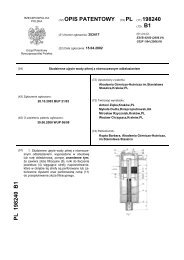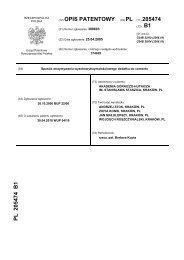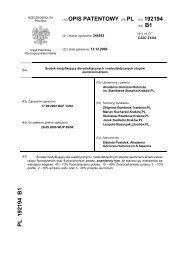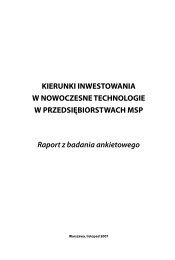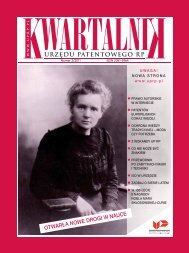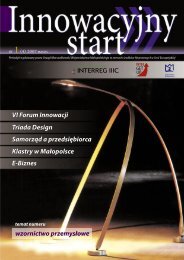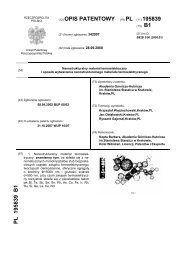Wyd. specjalne/2011 - Regionalny OÅrodek Informacji Patentowej ...
Wyd. specjalne/2011 - Regionalny OÅrodek Informacji Patentowej ...
Wyd. specjalne/2011 - Regionalny OÅrodek Informacji Patentowej ...
- No tags were found...
You also want an ePaper? Increase the reach of your titles
YUMPU automatically turns print PDFs into web optimized ePapers that Google loves.
the statutory conditions for granting the rightin registration for an industrial design have notbeen fulfilled. The right may also be declaredinvalid when exploitation of the design infringesthird parties’ personal or economic rights(Article 117 (2) of Industrial Property Law). Thelegislative technique used in the Polish lawto regulate this issue contradicts the requirementsof Directive 98/71/EC, i.e. Article 11and Recital 21 of the Preamble to the Directive,demonstrating that obstacles to the registrationof designs and grounds for declaring invaliditymust be exhaustively enumerated. The groupof relative grounds for refusing or invalidationof the registration contains cases where designsuse, without authorisation, indications which arenot subject to monopolization, specified in Article6ter of the Paris Convention. The provisionsof Article 131 (2) (2)-(5) of Industrial PropertyLaw, applicable to industrial designs in relationto Article 106 (2) of the same act, demonstratesignificant divergences from the provision of Article6ter of the Paris Convention.11. Article 11 (7) of the Directive providesfor the possibility to ‘restore’ the design registration,to partially invalidate the design and to partiallydisclaim the design right. The Polish lawfails to clearly regulate this matter, though thereare no obstacles to introduce this special ‘restoration’of registration of industrial designs aspart of the provisions in force.12. The last but not least issue refersto the special provision of coincidence of protectionunder the copyright law and underthe right in registration for an industrial designin the Polish law in Article 116 of IndustrialProperty Law.Pursuant to this provision, the protection of author’seconomic rights in a work of industrialdesign shall not apply to products manufacturedby means of an industrial design and puton the market after the lapse of the right in registrationfor such a design (i.e. due to the lapseof the 25-year term of protection of the designor failing to pay the fee for the subsequent5-year term of protection). Meanwhile, pursuantto Article 17 of Directive 98/71/EC, cumulationof special protection of designs and protectionunder the copyright law is the rule. Theprovision of Article 116 of Industrial PropertyLaw is contradictory to that provision 8 , aswell as to Article 1 of Directive 2006/116/ECof the European Parliament and of the Councilof 12 December 2006 on the term of protectionof copyright and certain related rights 9 regardingthe minimum term of protection of author’seconomic rights for 70 years after the deathof the author and to Articles 2 and 4 of Directive2001/29/EC of the European Parliamentand of the Council of 22 May 2001 on the harmonisationof certain aspects of copyrightand related rights in the information society 10 ,as well as to Article 7 (4) of the Berne Conventionregarding the minimum 25-year term of protectionof author’s economic rights and the requirementsof Community legislation.Unfortunately, only certain divergencesindicated above may be eliminated as partof the Community conforming interpretationof national law. The majority of themrequires intervention of the Polish legislatorwith the aim of removing the fundamentaldefects by way of amendment to the Law.Dr. Anna Tischner1 OJ EU L 1998.289.28. Very low language qualityof the Polish version of the Directive should be bornein mind, however.2 Dz.U. No 108, item 945.3 The category of industrial designs was introduced intoPolish law only by the Industrial Property Law. Previously,the category of ornamental designs for aestheticpurposes was protected by the Regulation of the Councilof Ministers of 29 January, 1963 on the protectionof ornamental designs (Journal of Laws, No 8,text 45).4 Cf. however, Article 36 (6) of the Regulation No6/2002 on Community designs, containing explicitprovision that demonstration of products which areto embody the design does not affect the scopeof protection arising from the registration of the design.5 Cf. K. Szczepanowska-Kozłowska, Pojęcie wzoruprzemysłowego – między funkcjonalnością a estetyką,PPH 2010, No 3, p. 13. The author aptly callsfor the deletion of Article 102 (3) (3) of IndustrialProperty Law as it is noncompliant with Directive98/71/EC.6 Dz. U. Nr 136, poz. 958.7 Cf. Article 115 Subparagraph 7 of Industrial PropertyLaw, allowing for reproduction of component partsof a complex product, as part of execution, on anindividual order, of repairs, in force also beforethe amendment of 2007.8 The repair clause provided for in Article 1061 of IndustrialProperty Law also applies to industrial designsregistered in Poland on the day of entry into forceof the amended act, i.e. 1.11.2007.9 Cf. judgment of the Court of Justice of 27.01.<strong>2011</strong>in Case C-168/09.10 OJ L 372/1, 27.12.2006.11 OJ L 167/10, 22.6.2001.Zgodnie z ustawą Prawo własnościprzemysłowej (dalej u.p.w.p.) „wzoremprzemysłowym” jest „nowa i posiadającaindywidualny charakter postać wytworu lubjego część nadana mu w szczególnościprzez cechy linii, konturów, kształtów, kolorystykę,strukturę lub materiał wytworu orazjego ornamentację” (art. 102 ust. 1 u.p.w.p.).Wzór, by mógł skorzystać z ochrony, musibyć wzorem nowym i posiadać indywidualnycharakter.NowośćPierwszy z wymogów to wymógnowości, który musi być spełnionyprzez każdy wzór, niezależnieod tego, czy jest to wzór zarejestrowany,czy też nie, a także niezależnieod tego,czy ubiegamysię o ochronęna szczebluwspólnotowym,czy tylkow Polsce.Wzór przemysłowyuważasię za nowy,jeżeli przeddatą, wedługktórej oznaczasię pierwszeństwodo uzyskania prawa z rejestracji, identycznywzór nie został udostępniony publicznieprzez stosowanie, wystawienie lub ujawnieniew inny sposób. (art. 103 ust. 1 u.p.w.p.).Jak wynika z powyższego, ocena nowościwzoru przemysłowego wymaga uwzględnieniadwóch czynników: wcześniejszego udostępnieniapublicznego wzoru oraz ustaleniaróżnicy między dwoma wzorami.Udostępnienie publiczneWzór przemysłowy uważa się za udostępnionypublicznie, jeżeli był wcześniej:1) stosowany,2) wystawiony,3) lub ujawniony w inny sposób, ale tylkow przypadku, gdy wzór mógł dotrzeć44 • KWARTALNIK URZĘDU PATENTOWEGO RP <strong>Wyd</strong>anie <strong>specjalne</strong>




